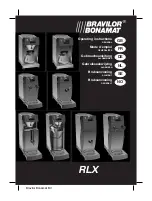
1A-390 Engine Control System (4HK1)
The ECM controls the duty ratio of the linear type fuel
rail pressure (FRP) regulator (the length of time that the
current is applied to the FRP regulator), in order to
control the quantity of fuel that is supplied to the high-
pressure plungers. Since only the quantity of fuel that is
required for achieving the target rail pressure is drawn
in, the drive load of the supply pump is decreased.
When current flows to the FRP regulator, variable
electromotive force is created in accordance with the
duty ratio, moving the armature to the left side. The
armature moves the cylinder to the left side, changing
the opening of the fuel passage and thus regulating the
fuel quantity. With the FRP regulator OFF, the return
spring contracts, completely opening the fuel passage
and supplying fuel to the plungers (Full quantity intake
and full quantity discharge). When the FRP regulator is
ON, the force of the return spring moves the cylinder to
the right, closing the fuel passage (normally opened).
By turning the FRP regulator ON/OFF, fuel is supplied
in an amount corresponding to the actuation duty ratio,
and fuel is discharged by the plungers.
Fuel Injection System Description
Fuel Injection Quantity Control
This control determines the fuel injection quantity by
adding coolant temperature, fuel temperature, intake
air temperature, barometric pressure and some switch
inputs information corrections to the basic injection
quantity is calculated by the ECM based on the engine
operating conditions (engine speed, accelerator pedal
pressing amount and boost pressure sensor). More fuel
rate indicates if the engine load is increased as the
accelerator pedal is stepped on at constant engine
speed.
Combined with high pressure injection of atomized fuel,
this control improves exhaust gas and ensures proper
fuel consumption. Compared with conventional
mechanical governors, an electronic control system
provides higher degree of freedom of fuel injection
quantity control, thereby presenting high accelerator
response (acceleration feeling and pressing feeling).
Starting Injection Quantity Control
At the engine starting (after the key switch is turned to
the START position to start the engine, up to return of
key switch to the ON position), optimum fuel injection
quantity is controlled based on the information on the
engine speed and coolant temperature. At low
temperature, the fuel injection quantity increases.
When the engine started completely, this boosted
quantity mode at the starting is cancelled and normal
running mode is restored.
Idle Speed Control
A control is made so as to achieve stable idling speed
at all time regardless of engine secular changes or
engine condition variations. The ECM sets target idling
speed and controls the fuel injection quantity according
to the engine conditions (actual engine speed, coolant
temperature and engine load) to follow actual engine
speed to the target idling speed so as to ensure stable
idling speed.
Idle Vibration Control
A control is made so as to reduce the engine vibration
caused by torque variations between cylinders due to
variations in fuel injection quantity of each cylinder or
injector performance. The ECM corrects the injection
quantity between cylinders based on the revolution
signals from the crankshaft position (CKP) sensor.
Normal range of correction quantity between cylinders
is within
±
5 mm
3
.
Exhaust Gas Recirculation (EGR) System
Description
Legend
1. ECM
2. EGR valve
3. Engine coolant outlet
4. Engine coolant inlet
5. EGR cooler
6. Intake throttle valve
7. MAF sensor
LNW76ESH003801
6
7
1
2
3
5
4
LG4HKED-WE-0871.book 390
ページ
2007年11月29日 木曜日 午後6時29分
Содержание 2008MY N Series
Страница 3: ......
Страница 401: ...MEMO LG4HKED WE 0871 book 1...
Страница 403: ......
Страница 404: ...WORKSHOP MANUAL ENGINE CONTROL SYSTEM 4HK1 model No LG4HKED WE 0871 WORKSHOP MANUAL ENGINE CONTROL SYSTEM 4HK1 model...












































